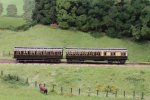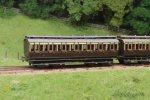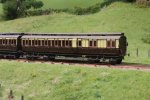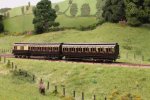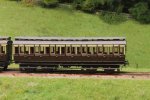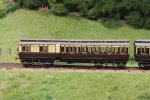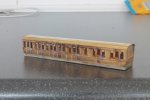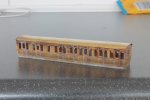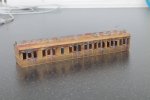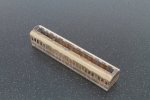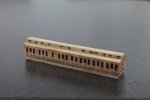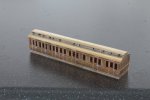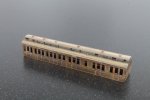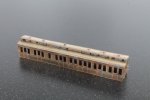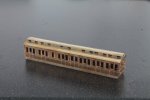As a bit of a change from making and painting coaches, I've begun adding a little more life (or rather wildlife) to Modbury.
The catalyst for actually getting on and doing something (as I've intended to do this for quite some time) is an invite to the Manchester exhibition in December. In filling out the documentation requesting all of the normal things like size of layout, number of sockets required, etc, at the end was a little section asking for a couple of questions for children to answer as a type of "treasure hunt" (something along the lines of “How many dogs in the main street of Dewsbury Midland?”).
Now, I must admit that I've never considered a target audience of children for Modbury (although we do have a series of little cameos on St. Ruth for children to find - my effort was a picnicking family whose child has got her kite stuck in one of the trees). However, although there are some "cameos" on Modbury they are there more to breathe life into the scene rather than the "can you spot ..." kinds of things.
Examples of the "cameos" already in existence :
 Couple awaiting their train for a day out in Torquay
Couple awaiting their train for a day out in Torquay
 Sisters patiently waiting for their train for their "new hat" shopping trip to Exeter
Sisters patiently waiting for their train for their "new hat" shopping trip to Exeter
 Coal merchant John Clarke discussing business with a customer
Coal merchant John Clarke discussing business with a customer
So back to the wildlife!!! I intend to model some rabbits at some point but decided some bird life would be a nice touch to start with. Now, clearly in 2mm scale something like a wren or even a blackbird would be a bit pointless, so I've elected to model something a little larger - some pheasant. According to my ancient "Observers Book of British Birds" :

The pheasant would be between 4 and 6mm long in 2mm scale, so actually reasonably visible. These little chaps (and chapess) were simply formed with a length of 0.45mm brass wire for head body and tail (left over long at each end!!), with a couple of twists of 0.3mm wire to bulk out the body and provide a leg to mount in the scenery. Once soldered together, further 70 degree solder was used to build up a bit more mass before final bending to shape and thinning with a small needle file.
Unfortunately I forgot to take any construction photos, but once primed and painted the results were quite pleasing (although difficult to photo) :


It was then a simple matter of deciding where to put them - in the end I elected to put them where they would be most visible (at the front of the layout around the hedge that disguises the board joint) :
 The lone male looking for something tasty in the grass
The lone male looking for something tasty in the grass
 And on the other side of the hedge the "old married couple". I have since touched up the male as I had inadvertently damaged his plumage with my tweezers as I forced his leg into the ground.
And on the other side of the hedge the "old married couple". I have since touched up the male as I had inadvertently damaged his plumage with my tweezers as I forced his leg into the ground.
One thing I did notice a couple of weeks ago was that one of my platform trolleys had been lost in transit at one of the recent exhibitions. The missing trolley was part of another small cameo on the down platform consisting of a couple who were taking some of their produce from their market garden to sell in Plymouth. The original trolley had a couple of crates of greenery on it, but having to create a replacement has led to something a little more adventurous!
The trolley itself is one of my own etchings which was soldered/superglued up and painted. I then made a couple of wooden boxes (I felt that wicker baskets were a little too tricky although I did try weaving some 0.1mm wire between staves a little thicker!) from 0.005" plasticard with a 0.015" bottom. An additional pair of stacked crates was also made from small squares of 0.020" plasticard, the middle layer having its sides filed away to leave small squares at each corner to represent the upstanding corners of the lower crate. Once painted, the voids in the side of the middle layer were dressed with a little green flock, as was the top. The two wooden boxes have been filled with cauliflowers and cabbages - the hearts of each being small balls of pre-coloured tissue, then outer leaves of more pre-coloured tissue being added. Once dry a few cabbages were glued in one box and cauli's in the other.


That's all for now. Thank you for looking.
Ian

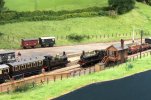

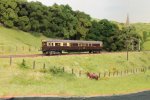


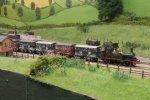

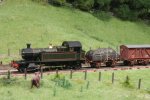
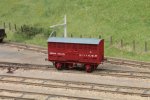
 )
)